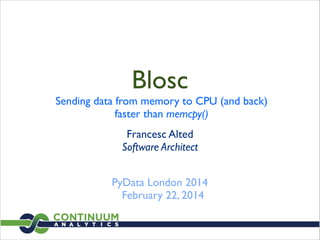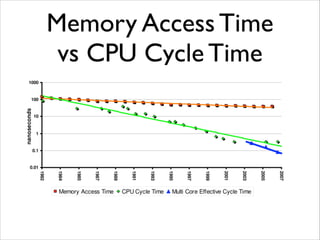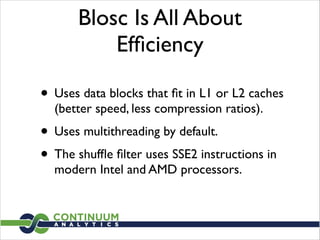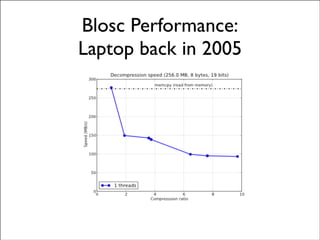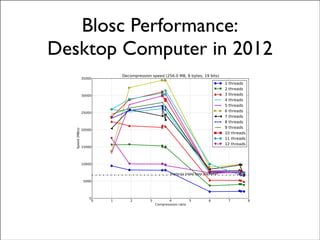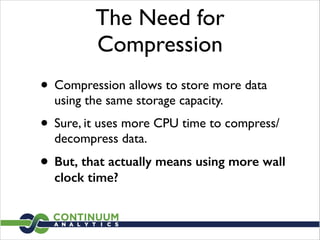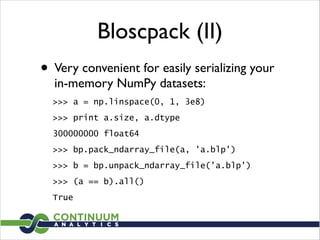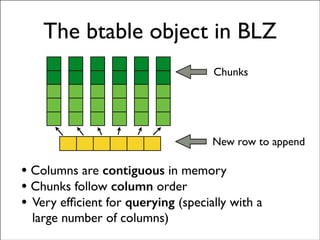Blosc: Sending Data from Memory to CPU (and back) Faster than Memcpy by Francesc Alted
- 1. Blosc Sending data from memory to CPU (and back) faster than memcpy() Francesc Alted Software Architect PyData London 2014 February 22, 2014
- 2. About Me • I am the creator of tools like PyTables, Blosc, BLZ and maintainer of Numexpr. • I learnt the hard way that ‘premature optimization is the root of all evil’. • Now I only humbly try to optimize if I really need to and I just hope that Blosc is not an example of ‘premature optimization’.
- 3. About Continuum Analytics • Develop new ways on how data is stored, computed, and visualized. • Provide open technologies for data integration on a massive scale. • Provide software tools, training, and integration/consulting services to corporate, government, and educational clients worldwide.
- 4. Overview • Compressing faster than memcpy(). Really? • How that can be? (The ‘Starving CPU’ problem) • How Blosc works. • Being faster than memcpy() means that my programs would actually run faster?
- 6. Interactive Session Starts • If you want to experiment with Blosc in your own machine: http://www.blosc.org/materials/PyData- London-2014.tar.gz • blosc (blz too for later on) is required (both are included in conda repository).
- 7. Open Questions We have seen that, sometimes, Blosc can actually be faster than memcpy(). Now: 1. If compression takes way more CPU than memcpy(), why Blosc can beat it? 2. Does this mean that Blosc can actually accelerate computations in real scenarios?
- 8. The Starving CPU Problem “Across the industry, today’s chips are largely able to execute code faster than we can feed them with instructions and data.” ! – Richard Sites, after his article “It’sThe Memory, Stupid!”, Microprocessor Report, 10(10),1996
- 9. Memory Access Time vs CPU Cycle Time
- 10. Book in 2009
- 11. The Status of CPU Starvation in 2014 • Memory latency (~10 ns) is much slower (between 100x and 250x) than processors. • Memory bandwidth (~15 GB/s) is improving at a better rate than memory latency, but it is also slower than processors (between 30x and 100x).
- 13. Blosc: (de)compressing faster than memcpy() Transmission + decompression faster than direct transfer?
- 14. Taking Advantage of Memory-CPU Gap • Blosc is meant to discover redundancy in data as fast as possible. • It comes with a series of fast compressors: BloscLZ, LZ4, Snappy, LZ4HC and Zlib • Blosc is meant for speed, not for high compression ratios.
- 15. Blosc Is All About Efficiency • Uses data blocks that fit in L1 or L2 caches (better speed, less compression ratios). • Uses multithreading by default. • The shuffle filter uses SSE2 instructions in modern Intel and AMD processors.
- 17. Suffling: Improving the Compression Ratio The shuffling algorithm does not actually compress the data; it rather changes the byte order in the data stream:
- 18. Shuffling Caveat • Shuffling usually produces better compression ratios with numerical data, except when it does not. • If you mind about the compression ratio, it is worth to deactivate it and check (it is active by default). • Will see an example on real data later on.
- 19. Blosc Performance: Laptop back in 2005
- 20. Blosc Performance: Desktop Computer in 2012
- 21. First Answer for Open Questions • Blosc data blocking optimizes the cache behavior during memory access. • Additionally, it uses multithreading and SIMD instructions. • Add these to the Starved CPU problem and you have a good hint now on why Blosc can beat memcpy().
- 22. How Compression Works With Real Data?
- 23. The Need for Compression • Compression allows to store more data using the same storage capacity. • Sure, it uses more CPU time to compress/ decompress data. • But, that actually means using more wall clock time?
- 24. The Need for a Compressed Container • A compressed container is meant to store data in compressed state and transparently deliver it uncompressed. • That means that the user only perceives that her dataset takes less memory. • Only less space? What about data access speed?
- 25. Source: Howison, M. High-throughput compression of FASTQ data with SeqDB. IEEE Transactions on Computational Biology and Bioinformatics. Example of How Blosc Accelerates Genomics I/O: SeqDB (backed by Blosc)
- 26. Bloscpack (I) • Command line interface and serialization format for Blosc: ! $ blpk c data.dat # compress $ blpk d data.dat.blp # decompress
- 27. Bloscpack (II) • Very convenient for easily serializing your in-memory NumPy datasets: >>> a = np.linspace(0, 1, 3e8) >>> print a.size, a.dtype 300000000 float64 >>> bp.pack_ndarray_file(a, 'a.blp') >>> b = bp.unpack_ndarray_file('a.blp') >>> (a == b).all() True
- 28. Yet Another Example: BLZ • BLZ is a both a format and library that has been designed as an efficient data container for Big Data. • Blosc and Bloscpack are at the heart of it in order to achieve high-speed compression/ decompression. • BLZ is one of the backends supported by our nascent Blaze library.
- 29. Appending Data in Large NumPy Objects Copy! New memory allocation array to be enlarged final array object new data to append • Normally a realloc() syscall will not succeed • Both memory areas have to exist simultaneously
- 30. Contiguous vs Chunked NumPy container Contiguous memory BLZ container chunk 1 chunk 2 Discontiguous memory chunk N ...
- 31. Appending data in BLZ compress new chunk array to be enlarged final array object new data to append Only a small amount of data has to be compressed X chunk 1 chunk 2 chunk 1 chunk 2
- 32. The btable object in BLZ New row to append • Columns are contiguous in memory • Chunks follow column order • Very efficient for querying (specially with a large number of columns) Chunks
- 33. Second Interactive Session: BLZ and Blosc on a Real Dataset
- 34. Second Hint for Open Questions Blosc usage in BLZ means not only less storage usage (~15x-40x reduction for the real life data shown), but almost the same access time to the data (~2x-10x slowdown). (Still need to address implementation details for getting better performance)
- 35. Summary • Blosc, being able to transfer data faster than memcpy(), has enormous implications on data management. • It is well suited not only for saving memory, but for allowing close performance to typical uncompressed data containers. • It works well not only for synthetic data, but also for real-life datasets.
- 36. References • Blosc: http://www.blosc.org • Bloscpack: https://github.com/Blosc/bloscpack • BLZ: http://blz.pydata.org
- 37. “Across the industry, today’s chips are largely able to execute code faster than we can feed them with instructions and data. There are no longer performance bottlenecks in the floating-point multiplier or in having only a single integer unit. The real design action is in memory subsystems— caches, buses, bandwidth, and latency.” ! “Over the coming decade, memory subsystem design will be the only important design issue for microprocessors.” ! – Richard Sites, after his article “It’sThe Memory, Stupid!”, Microprocessor Report, 10(10),1996 “Over this decade (2010-2020), memory subsystem optimization will be (almost) the only important design issue for improving performance.” – Me :)
- 38. Thank you!

